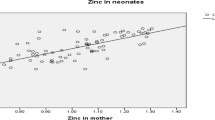Abstract
The study was conducted to assess copper and zinc levels in neonate’s serum, mother’s serum, neonate’s hair and urine and to ascertain association between them. It is of concern whether zinc and copper deficiency is present at birth and maternal blood and breast milk zinc and copper levels have any effect on this.
The study sample included 155 neonates with gestational age 26–41 wks and birth weight 0.550-3.800 kg. Mother’s serum, breast milk, neonate’s serum, hair, urine samples were analysed for zinc and copper by atomic absorption spectrophotometry. Gestational age was estimated either singly or by combination of date of last normal menses, fetal ultrasonography, and postnatal measures of physical and neurological development by clinical examination and weight by Secca electronic balance. The neonates were classified into term and preterm, small (SGA) and appropriate for gestational age (AGA). Neonates over 37 wks and 2.5 kg served as controls. To assess the dependency, relationship and effectiveness of quantitative predictive variables on the predictions of values, multiple regression analysis was used.
Neonates between 26–30 wks gestational age and <2.5 kg birth weight had significantly low serum zinc and copper. Breast milk zinc was low in mothers delivering preterm and <2.5 kg neonates. Urinary copper and zinc levels were high in preterm appropriate for gestational age (Pre AGA) than term neonates. Multiple regression analysis revealed that neonate’s serum Cu, serum Zn, hair Cu, hair Zn, urine Cu and urine Zn had contribution variability of 49.8%, 51.8%, 49.2%, 16.6%, 52.2% and 68.9%, respectively. The effect of mother’s serum, breast milk, and neonate’s serum copper and zinc collectively was significant for serum copper (F = 29.59) and hair zinc (F = 32.03).
Preterm and low birth weight infants during subsequent growth and development should be supplemented with zinc and copper when on breast feeding
Similar content being viewed by others
References
Tyrala EE. Zinc and copper balances infants.Pediatrics. 1986; 77: 513–517.
Burns J, Forsyth JS, Paterson CR. Factors associated with variation in plasma copper levels in preterm infants of very low birth weight.Eur J Pediatr.1993; 152: 240–243.
Prasad AS. Zinc deficiency in women, infants and children.J Am Coll Nutr 1996; 15:113–120.
Kliegman RM. The fetus and neonatal infant. In: Behrman, Kliegman, Arvin, (ed).Nelson Textbook of Pediatrics. Philadelphia: Saunders, 15th edn. 1996; pp 431–513.
WHO/IAEA collaborative study. Minor and Trace Elements in Breast Milk. World Organization : Geneva, 1989.
Sharda B, Bhandari B, Bhandari LM. Copper, zinc, magnesium and cadmium levels of breast milk of Indian women.Trans Roy Soc Trop Med Hy 1983; 77:201–203.
Sharda B, Bhandari B. Copper concentration in plasma, cells, liver, urine hair and nails in hepatobiliary disorders in children.Indian Pediatr 1984; 21:167–171.
Milne DB. Trace elements. In: Burti CA, Ashwood ER (eds)Teitz Textbook of Clinical Chemistry. Philadelphia : Saunders, 2nd ed. 1994; pp 1317–1353.
Heinen F, Matern D, Pringsheim W, Leititis JU, Brandis M. Zinc deficiency in an exclusively breast-fed preterm infant.Eur J Pediatr 1995; 154:71–75.
Castillo-Duran C, Rodrigues A, Venegas G, Alvarez P, Icaza G. Zinc supplementation and growth of infants born small for gestational age.J Pediatr 1995; 17: 206–211.
Murphy JF, Gray OP, Rendall JR, Hann S. Zinc deficiency: a problem with preterm breast milk.Early Human Dev 1985; 10 : 303–307.
Friel JK, Andrews WL. Zinc requirement of preterm infants.Nutrition 1994; 10: 63–65.
Ohtake M, Tamura T. Changes in zinc and copper concentration in breast milk and blood of Japanese women during lactation.J Nutr Sci Vitaminol 1993; 39:189–200.
Dorner K, Dziadzka S, Hohn Aet al. Longitudinal manganese and copper balances in young infants fed on breast milk and adapted cow’s milk formulas.Br J Nutri 1989; 61: 559–572.
Bier JAB, Ferguson AE, Morales Y, Liebling JA, Oh W, Vohr BR. Breastfeeding infants who were exclusively low birth weight.Pediatrics 1997; 100 (6) : URL. http://www.pediatrics.org/cgi/content/ full/100/6/e3.
Author information
Authors and Affiliations
Rights and permissions
About this article
Cite this article
Sharda, B., Adhikari, R., Ajmera, M. et al. Zinc and copper in preterm neonates: Relationship with breast milk. Indian J Pediatr 66, 685–695 (1999). https://doi.org/10.1007/BF02726255
Issue Date:
DOI: https://doi.org/10.1007/BF02726255




